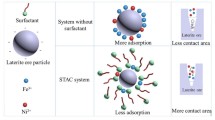Abstract
Radioactively contaminated metal components are generated during the operation or decommissioning of a nuclear power plant. These metals can be effectively decontaminated using a foam containing H2SO4 and Ce(IV) with significant reduction of radioactive liquid wastes. However, this decontamination method generates strong acidic wastewater containing a high concentration of a surfactant and ionic materials with radioactive nuclides. Treating this wastewater by using precipitation and filtration is not appropriate considering efficiency and waste generation. In this study, an integrated process of precipitation and low pressure evaporation was evaluated for the treatment of wastewater. It was confirmed that the ionic materials were separated at an efficiency above 99.9% without secondary waste generation, and the surfactant was reduced to 1/35 through this integrated process.






Similar content being viewed by others
Data Availability
The authors declare that all data supporting the findings of this study are available within the article.
References
Abdel Rahman, R. O., Ibrahium, H. A., & Hung, Y. T. (2011). Liquid radioactive wastes treatment: A review. Water, 3, 551–565.
Choi, W., Choi, M., & Kim, S. (2020). Performance of foam decontamination for fixed radioactive contamination. Transactions of the Korean Nuclear Society Virtual Spring Meeting, 20S-567, July 9–10, Korea.
Dame, C., Fritz, C., Pitois, O., & Faure, S. (2005). Relations between physicochemical properties and instability of decontamination foams. Colloids and Surfaces a: Physicochemical and Engineering Aspects, 263, 210–218.
Deleurence, R., Saison, T., Lequeux, F., & Monteux, C. (2015). Time scales for drainage and imbibition in gellified forms: Application to decontamination processes. Soft Matter, 11, 7032–7037.
Eun, H. C., Chang, N. O., Kim, S. B., & Seo, B. K. (2021). Feasibility study on immobilization of radioactive cobalt and BaSO4 waste powder using low-temperature sintering. Water Air and Soil Pollution, 232, 333.
Ferrara, F., Fabietti, F., Delise, M., & Funari, E. (2005). Alkylphenols and alkylphenol ethoxylates contamination of crustaceans and fishes from the Adriatic Sea (Italy). Chemosphere, 59, 1145–1150.
Gutierrez, G., Bentio, J. M., Coca, J., & Pazos, C. (2010). Vacuum evaporation of surfactant solutions and oil-water emulsions. Chemical Engineering Journal, 162, 201–207.
Hill, C., & Eastoe, J. (2017). Foams: From nature to industry. Advances in Colloid and Interface Science, 247, 496–513.
Jung, J., Eun, H., Park, S., Park, J., Chang, N., Kim, S., Seo, B., & Park, S. (2018). A study on the removal of impurities in a SP-HyBRID decontamination wastewater of the primary coolant system in a pressurized water reactor. Journal of Radioanalytical and Nuclear Chemistry, 318, 1339–1345.
McGrandy, J., Duff, J., Stevens, N., Cioncolini, A., Curioni, M., Banks, A., & Scenini, F. (2017). Development of a microfluidic setup to study the corrosion product deposition in accelerated flow regions. npj Materials Degradation, 1, 21.
Motteran, F., Braga, J. K., Sakamoto, I. K., Silva, E. L., & Varesche, M. B. A. (2014). Degradation of high concentrations of nonionic surfactant (linear alcohol ethoxylate) in an anaerobic fluidized bed reactor. Science of the Total Environment, 481, 121–128.
Mozia, S., Tomaszewska, M., & Morawski, A. W. (2005). Decomposition of nonionic surfactant in a labyrinth flow photoreactor with immobilized TiO2 bed. Applied Catalysis b: Environmental, 59, 155–160.
Nogueria, T. A. R., deMelo, W. J., Fonseca, I. M., Marques, M. O., & He, Z. (2010). Barium uptake by maize plants as affected by sewage sludge in a long-term field study. Journal of Hazardous Materials, 181, 1148–1157.
Nguyen, H. M., Phan, C. M., Sen, T., & Hoang, S. A. (2015). TOC removal from laundry wastewater by photoelectrochemical process on Fe2O3 nanostructure. Desalination and Water Treatment, 57(31), 14379–14385.
Olmez-Hanci, T., Arslan-Alaton, I., & Genc, B. (2014). Degradation of the nonoionic surfactant Triton™ X-45 with HO▪ and SO▪4- — Based advanced oxidation processes. Chemical Engineering Journal, 239, 332–340.
Pagano, M., Volpe, A., Mascolo, G., Lopex, A., Locaputo, V., & Ciannarella, R. (2012). Peroxymonosulfate-Co(II) oxidation system for the removal of the non-ionic surfactant Brij 35 from aqueous solution. Chemosphere, 86, 329–334.
Roberts, J., Marshall, S. J., & Roberts, D. (2007). Aquatic toxicity of ethoxylated and propoxylated alcohols to Daphnia magna. Environmental Toxicology and Chemistry, 26(1), 68–72.
Ronie, A. (2019). Outokumpu HSC chemistry for windows. Pori Finland: OutoKumpu Research.
Rufus, A. L., Sathyaseelan, V. S., Pavithra, E., & Velmurugan, S. (2019). Dissolution of corrosion product oxides relevant to nuclear power plants in formulations containing chromous complexes. Journal of Nuclear Materials, 520, 121–130.
Yoon, I. H., Kim, S. E., Choi, M., Kim, S., Choi, W. K., & Jung, C. H. (2020). Highly enhanced foams for stability and decontamination efficiency with a fluorosurfactant, silica nanoparticles, and Ce(IV) in radiological application. Environmental Technology and Innovation, 18, 100744.
Yoon, I. H., Yoon, S. B., Shin, Y., Choi, M. S., Jung, C. H., & Choi, W. K. (2021). Stabilizing decontamination foam using surface-modified silica nanoparticles containing chemical reagent: Foam stability, structures, and dispersion properties. RSC Advances, 11, 1841–1849.
Funding
The authors would like to express their appreciation for the support provided by the National Research Foundation of Korea (NRF), which is funded by the Ministry of Science, ICT and Future Planning (MSIP) of the Republic of Korea (RS-2022–00155421).
Author information
Authors and Affiliations
Corresponding author
Ethics declarations
Conflict of Interest
The authors declare no competing interests.
Additional information
Publisher's Note
Springer Nature remains neutral with regard to jurisdictional claims in published maps and institutional affiliations.
Rights and permissions
Springer Nature or its licensor holds exclusive rights to this article under a publishing agreement with the author(s) or other rightsholder(s); author self-archiving of the accepted manuscript version of this article is solely governed by the terms of such publishing agreement and applicable law.
About this article
Cite this article
Eun, HC., Chang, NO., Lee, Sb. et al. A Study on Treatment of Strong Acidic Wastewater Containing a High Concentration of a Nonionic Surfactant and Ionic Materials with Radioactive Nuclides. Water Air Soil Pollut 233, 360 (2022). https://doi.org/10.1007/s11270-022-05832-1
Received:
Accepted:
Published:
DOI: https://doi.org/10.1007/s11270-022-05832-1



